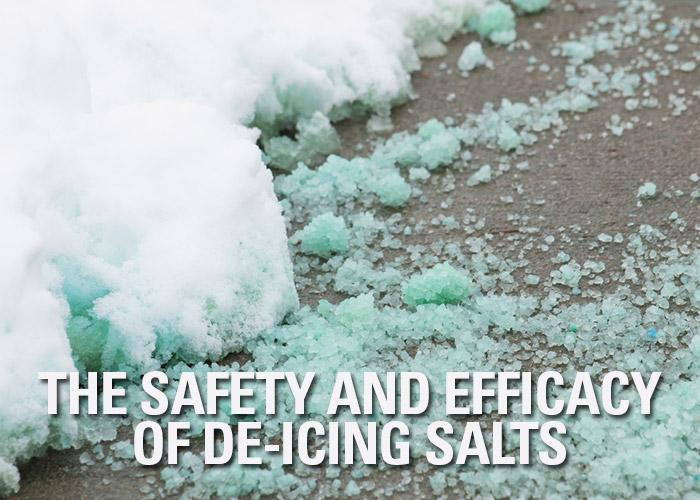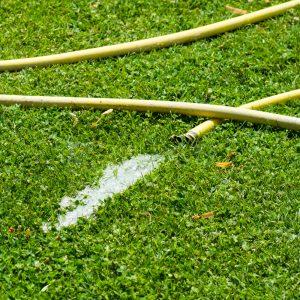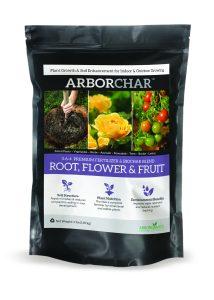Follow these tips from Arborjet’s Horticultural Specialist, Matt Andrus, to avoid salt damage to your plants. Andrus is a member of Arborjet’s research and development team, devoted to the discovery and development of the most effective equipment, formulations and application methods.
What is deicing salt?
“Many ice melt products are composed primarily of sodium chloride, commonly known as rock salt, which is inexpensive at less than ten dollars per fifty pound bag. This product needs to be used when temperatures are above 20 degrees or it will not dissolve ice. Sodium chloride will damage lawns and plants, as well as the undercarriages of vehicles as it is corrosive to unprotected metals. Other options are better suited for ice melting due to its slow acting nature and high level of toxicity.
Calcium chloride is a common deicing salt, which is exported worldwide from the United States. This product retails for about twice the price as sodium chloride per pound. It is fast acting and works well in extremely low temperatures, down to approximately -25 degrees. You can use this product in New England at any time and have success. It is less toxic than sodium chloride but more toxic than calcium magnesium acetate.
Imported magnesium chloride costs the same as calcium chloride and it is only effective to around zero degrees. It is less effective than sodium chloride and calcium chloride.
Calcium magnesium acetate (CMA) is the best option for plants and animals but is more costly at one hundred dollars for fifty pounds. CMA has a very low toxicity and the smart choice when considering plants and animals. To decrease cost this is usually sold as a blend with some of the other more toxic options to stretch it.
Pet Friendly Ice Melt
If it doesn’t say pet safe on the label that doesn’t necessarily mean that it is unsafe for pets. Most pet friendly products are a blend of Calcium Chloride, CMA and other things such as urea or potassium chloride. Have you ever had a dog that yelped when walking on a salted surface? The moisture in the pads on their feet is being pulled out by the salt particles which causes splitting and cracking on their pads. Before it visibly splits and cracks, the area becomes dry, brittle and sensitive. This is why we do not handle ice melt directly. Use a cup or scoop instead to avoid damage to the skin.
Consider the Timing
Wait until ice forms or snow falls before using salt on concrete surfaces to avoid cracking. Apply it on the snow and ice to dissolve properly. Once the ice or snow is melted, remove the salt from the surface. Less is more with any of these deicers. Generous applications generally cause more problems in the long run, damaging plants in the spring.
Scorching
Sodium draws out the moisture from the roots and leaves. When the snow and ice melt off the sidewalk, the saltwater runs into the soil. This is why you start observing marginal burns that discolor the leaves around the edges first. To preserve itself the plant will discard the leaves around the edges, as the moisture leaves the plant to preserve the stalk or core. When saltwater gets splashed onto leaves, you get contact that directly draws moisture out of the surface of the leaf, which ends up scorched.
Salt Build-Up
Salt build up in the soil reduces the oxygen content and increases compaction. These two things contribute to plant damage by removing moisture from the leaves and oxygen from the soil. Increased compaction hurts the roots and harms development in the spring. This is extremely detrimental internally as the plant reduces nutrient uptake. Potassium and magnesium uptake are particularly impacted because sodium uses the same delivery system as potassium and magnesium, which takes valuable space and energy from the plant. We use extraordinary amounts of salt on sidewalks and driveways. This causes serious problems not only because of the physical injuries, but internally it is getting in the way of things the plant needs.
These compounding factors reduce the plants overall cold hardiness. What survives is more susceptible to injuries, which may lead to insect and disease pressures in the spring. New tender leaves that look like they are growing normally may have salt toxicities that are inviting insect and disease pressures. Using too much salt in the winter can have long lasting detrimental effects through the fall, the drought season and into the next winter.
Problem Areas
Some people have problem areas around their house, which may be caused by salt toxicities. If this happens, flush the soil in the spring. Soak leaves and evergreen needles with water to dilute the sodium and spread it out, away from the roots. Limit the amount of damage by being proactive and diluting before the growing season.
In plant areas, try to use something that doesn’t kill plants. There are other things you can use, such as rocks or sand, to create traction to walkways with plants around it instead of using salt. We recommend cutting salt usage on walkways with sand, gravel or sawdust.
Symptoms
In spring, look for signs of damage such as marginal browning, scorched patches on leaves, twig dieback or complete defoliation. The side exposed to the sidewalk can develop patching, where one side of the plant looks damaged and the other half appears healthy. This is also a sign that damage is occurring.
Tolerance Levels
If you have been experiencing problems with salt toxicity you may want to try planting a plant that is less sensitive. A few common plants that may be susceptible to salt damage include dogwood, black walnuts, Norway spruce, Douglas fir and eastern hemlock. Red maples and sugar maples are extremely popular here in the northeast but have a very low tolerance to salt, so they look poor quickly. For Cape Cod cranberry growers, high bush cranberries are terrible for salt toxicities.
Norway maples, many species of birch, honey locust, Colorado blue spruce, ponderosa pines, black locust, and poplars are very salt tolerant and less susceptible to damage.
Salt Damage Prevention
Increasing microbiology (microbes) populations in the soil can mediate excess salt availability and damage. Top dressing or amending manure, compost, or earthworm castings is a great way to introduce a wide variety of microorganisms in vast quantities. Also, stimulating the organisms with liquid or granular additions will ensure that the organisms acclimate and start breeding naturally. Arborjet offers many different options to invigorate microbes. NutriRoot™, a liquid amendment can easily be watered into the soil and covers a large area very quickly. ARBORChar™ (All Purpose Root, Flower & Fruit) is another great option to stimulate microbe growth. ARBORChar should be amended into the soil or it can be spread over a general area as long as it is covered by mulch, manure, compost or earthworm castings. Covering the ARBORChar will ensure that microbes can easily locate and utilize this product. Having dense populations and wide varieties of microbes can help disassociate salts and encourage the breakdown of excessive chemicals in your soil. The microbes create a well aerated soil that holds moisture more efficiently. With better air and water the plant can form a larger, more effective root system. Having a large healthy root system allows the plants to consume more nutrients which increases plant vigor. Vigorous, healthy plants are more resistance to chemical burns (salt damage) and winter injuries.
Three easy steps to reduce salt damage
1. Flush soils and rinse foliage in early spring to drastically reduce salt damage by diluting concentrated areas.
2. In the fall, amending microbe-rich products like compost and ARBORChar™ will increase the biology of the soil and mediate toxic levels of salt available to the plants.
3. Wrapping foliage with burlap, or some other permeable barrier, that is located in areas where salt is being used.
Being proactive and taking these simple steps will reduce the negative impact of salt usage, but, by far, the best way to avoid damage is to use the salt wisely and sparingly. Mixing deicing salt with sand, gravel or kitty litter is a more eco-friendly way to melt ice and increase traction without the risk of damaging sensitive plants located in high traffic areas.”
Do you have questions about NutriRoot™ or ARBORChar™? Contact us! Keep in touch with Arborjet on our Events page as well as on Facebook and Twitter.





